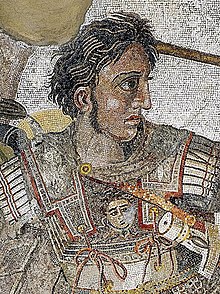The Mughal Empire was an early-modern Islamic empire that controlled much of South Asia between the 16th and 19th centuries.[10] For some two hundred years, the empire stretched from the outer fringes of the Indus river basin in the west, northern Afghanistan in the northwest, and Kashmir in the north, to the highlands of present-day Assam and Bangladesh in the east, and the uplands of the Deccan Plateau in South India.[11]
The Mughal empire is conventionally said to have been founded in 1526 by Babur, a warrior chieftain from what is today Uzbekistan, who employed aid from the neighboring Safavid and Ottoman empires,[12] to defeat the Sultan of Delhi, Ibrahim Lodi, in the First Battle of Panipat, and to sweep down the plains of North India. The Mughal imperial structure, however, is sometimes dated to 1600, to the rule of Babur's grandson, Akbar.[13] This imperial structure lasted until 1720, until shortly after the death of the last major emperor, Aurangzeb,[14][15] during whose reign the empire also achieved its maximum geographical extent. Reduced subsequently to the region in and around Old Delhi by 1760, the empire was formally dissolved by the British Raj after the Indian Rebellion of 1857.
Although the Mughal empire was created and sustained by military warfare,[16][17][18] it did not vigorously suppress the cultures and peoples it came to rule; rather it equalized and placated them through new administrative practices,[19][20] and diverse ruling elites, leading to more efficient, centralised, and standardized rule.[21] The base of the empire's collective wealth was agricultural taxes, instituted by the third Mughal emperor, Akbar.[22][23] These taxes, which amounted to well over half the output of a peasant cultivator,[24] were paid in the well-regulated silver currency,[21] and caused peasants and artisans to enter larger markets.[25]
The relative peace maintained by the empire during much of the 17th century was a factor in India's economic expansion.[26] Burgeoning European presence in the Indian Ocean, and its increasing demand for Indian raw and finished products, created still greater wealth in the Mughal courts.[27] There was more conspicuous consumption among the Mughal elite,[28] resulting in greater patronage of painting, literary forms, textiles, and architecture, especially during the reign of Shah Jahan.[29] Among the Mughal UNESCO World Heritage Sites in South Asia are: Agra Fort, Fatehpur Sikri, Red Fort, Humayun's Tomb, Lahore Fort, Shalamar Gardens and the Taj Mahal, which is described as "the jewel of Muslim art in India, and one of the universally admired masterpieces of the world's heritage."[30]
https://en.wikipedia.org/wiki/Mughal_Empire
The Timurid Empire (Persian: تیموریان), self-designated as Gurkani (Persian: گورکانیان Gūrkāniyān), was a late medieval, culturally Persianate[9] Turco-Mongol empire[10][11] that dominated Greater Iran in the early 15th century, comprising modern-day Iran, Iraq, Afghanistan, much of Central Asia, the South Caucasus, as well as parts of contemporary Pakistan, North India and Turkey. The empire was culturally hybrid, combining Turko-Mongolian and Persianate influences,[12][13] with the last members of the dynasty being "regarded as ideal Perso-Islamic rulers".[14]
Timurid Empire گورکانیان Gūrkāniyān | |
|---|---|
| 1370–1507 | |
| Motto: Persian:راستى رستى Rāstī rustī "In rectitude lies salvation" | |
 Map of the Timurid Empire at its greatest extent under Timur | |
| Status | Emirate |
| Capital | |
| Common languages | |
| Religion |
|
| Government | Absolute Monarchy |
| Emir | |
• 1370–1405 | Timur (first) |
• 1506–1507 | Badi' al-Zaman (last) |
| Historical era | Late Middle Ages |
| 1363 | |
• Establishment of Timurid Empire | 1370 |
• Westward expansion begins | 1380 |
| 20 July 1402 | |
• Fall of Samarkand | 1505 |
• Fall of Herat | 1507 |
• Founding of the Mughal Empire | 1526 |
| Area | |
| 1405 est.[7][8] | 4,400,000 km2 (1,700,000 sq mi) |
| Currency | Tanka |
https://en.wikipedia.org/wiki/Timurid_Empire
Transoxiana or Transoxania ("Land beyond the Oxus") is the Latin name for a region and civilization located in lower Central Asia roughly corresponding to modern-day eastern Uzbekistan, western Tajikistan, parts of southern Kazakhstan, parts of Turkmenistan and southern Kyrgyzstan. Geographically, it is the region between the rivers Amu Darya to its south and the Syr Darya to its north.[1]
Historically known in Persian as Farā-rūd (Persian: فرارود, [fæɾɒːˈɾuːd̪] – 'beyond the [Amu] river'), Faro-rüd (Tajik: Фарорӯд), and Varaz-rüd (Tajik: Варазрӯд), the area had been known to the ancient Iranians as Turan, a term used in the Persian national epic Shahnameh.[2] The corresponding Chinese term for the region is Hezhong (Chinese: 河中地区). The Arabic term Mā Warāʾ an-Nahr (Arabic: ما وراء النهر, [ˈmaː waˈraːʔ anˈnahr], which means "what is beyond the [Jayhūn] river") passed into Persian literary usage and stayed on until post-Mongol times.[3]
The region of Transoxiana was one of the satrapies (provinces) of the Achaemenid Empire of Persia under the name Sogdia. It was defined within the classical world of Persia to distinguish it from Iran proper, especially its northeastern province of Khorasan,[4] a term originating with the Sasanians,[5] although early Arab historians and geographers tended to subsume the region within the loosely defined term "Khorasan" designating a much larger territory.[6][7] The territories of Khwarazm, Sogdiana, Chaghaniyan, and Khuttal were located in the southern part of Transoxiana; Chach, Osrushana, and Farghana were located in the northern part.[8]
https://en.wikipedia.org/wiki/Transoxiana
Alexander III of Macedon (Ancient Greek: Ἀλέξανδρος, romanized: Alexandros; 20/21 July 356 BC – 10/11 June 323 BC), commonly known as Alexander the Great,[a] was a king of the ancient Greek kingdom of Macedon.[a] He succeeded his father Philip II to the throne in 336 BC at the age of 20, and spent most of his ruling years conducting a lengthy military campaign throughout Western Asia and Egypt. By the age of 30, he had created one of the largest empires in history, stretching from Greece to northwestern India.[2] He was undefeated in battle and is widely considered to be one of history's greatest and most successful military commanders.[3][4]
https://en.wikipedia.org/wiki/Alexander_the_Great
The Seleucid Empire (/sɪˈljuːsɪd/;[9] Ancient Greek: Βασιλεία τῶν Σελευκιδῶν, Basileía tōn Seleukidōn) was a Greek state[10][11] in West Asia that existed during the Hellenistic period from 312 BC to 63 BC. The Seleucid Empire was founded by the Macedonian general Seleucus I Nicator, following the division of the Macedonian Empire originally founded by Alexander the Great.[12][13][14][15]
After receiving the Mesopotamian region of Babylonia in 321 BC, Seleucus I began expanding his dominions to include the Near Eastern territories that encompass modern-day Iraq, Iran, Afghanistan, Syria, all of which had been under Macedonian control after the fall of the former Persian Achaemenid Empire. At the Seleucid Empire's height, it had consisted of territory that had covered Anatolia, Persia, the Levant, and what are now modern Iraq, Kuwait, Afghanistan, and parts of Turkmenistan.
The Seleucid Empire was a major center of Hellenistic culture. Greek customs and language were privileged; the wide variety of local traditions had been generally tolerated, while an urban Greek elite had formed the dominant political class and was reinforced by steady immigration from Greece.[15][16][17] The empire's western territories were repeatedly contested with Ptolemaic Egypt—a rival Hellenistic state. To the east, conflict with the Indian ruler Chandragupta of the Maurya Empire in 305 BC led to the cession of vast territory west of the Indus and a political alliance.
In the early second century BC, Antiochus III the Great attempted to project Seleucid power and authority into Hellenistic Greece, but his attempts were thwarted by the Roman Republic and its Greek allies. The Seleucids were forced to pay costly war reparations and had to relinquish territorial claims west of the Taurus Mountains in southern Anatolia, marking the gradual decline of their empire. Mithridates I of Parthia conquered much of the remaining eastern lands of the Seleucid Empire in the mid-second century BC, while the independent Greco-Bactrian Kingdom continued to flourish in the northeast. The Seleucid kings were thereafter reduced to a rump state in Syria, until their conquest by Tigranes the Great of Armenia in 83 BC, and ultimate overthrow by the Roman general Pompey in 63 BC.
https://en.wikipedia.org/wiki/Seleucid_Empire
The Greco-Bactrian Kingdom or simply Greco-Bactria,[2][3][a] was a Hellenistic-era Greek state,[4] and along with the Indo-Greek Kingdom, the easternmost part of the Hellenistic world in Central Asia and the Indian Subcontinent. It was founded in 256 BC by the Seleucid satrap Diodotus I Soter and lasted until its fall c. 120 BC. It was ruled by the Diodotids and rival Euthydemid dynasty.
It covered much of present-day Afghanistan, Uzbekistan, Tajikistan and Turkmenistan, and at its zenith, parts of Iran and Pakistan.[5] The capitals of Ai-Khanum and Bactra were among the largest and richest cities of antiquity; indeed, Bactria was itself known as the land of a thousand golden cities. The Indo-Greek Kingdoms, as Bactrian successor states, would last until 10 AD.[6][7][8]
https://en.wikipedia.org/wiki/Greco-Bactrian_Kingdom



No comments:
Post a Comment